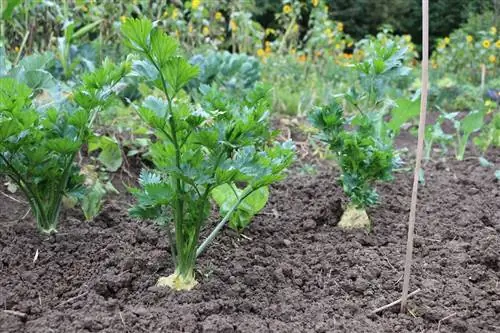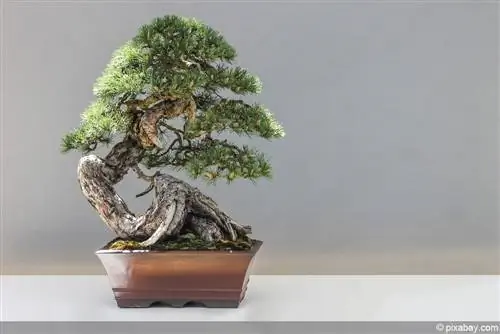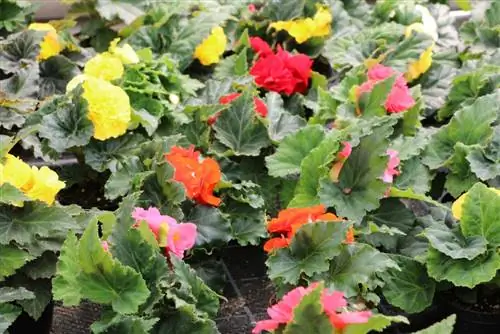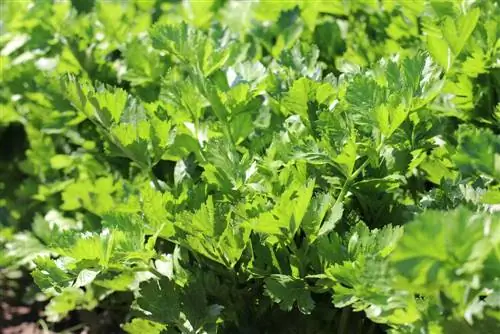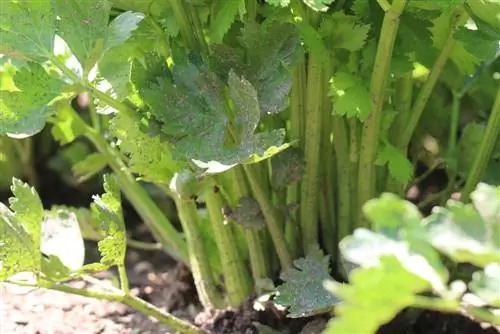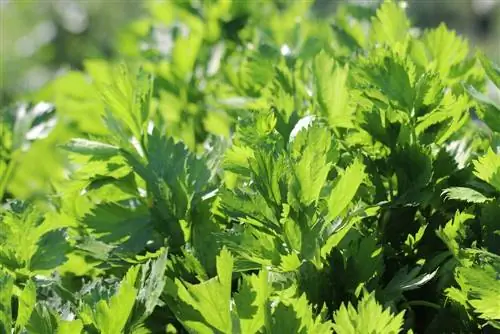- Author admin [email protected].
- Public 2023-12-17 03:39.
- Last modified 2025-01-24 12:45.
Celery is not just a popular soup vegetable. He is also he althy. It's even he althier to grow your own vegetables. You can find out how to do this here.
Profile
- Origin: Europe, America, Asia and Africa
- Plant family: Umbelliferae
- Type of vegetables: stem vegetables, tuber vegetables
- Variations: celeriac, celeriac, celery
- Growth: herbaceous plant
- Nutrient Requirements: Heavy Eaters
- Flowering: Umbels
- Propagation: Seeds
- Use: Soup or sauce seasoning, vegetables
- Special features: the aromatic smell is typical, celery can cause severe allergies
Variations
Celerium (Apium graveolens var. rapaceum)
This celery has a thickened tuber that can weigh up to a kilo. It is mainly used as a soup vegetable. Slices of the tuber can also be fried as celery cutlets.
Celery(Apium graveolens var. dulce)
The leaf stalks are used when growing celery or celery. Once they are long enough, they can be used individually or in groups, fresh or cooked.
Celery (Apium graveolens var. secalinum)
Spiced celery (also cut or leaf celery) is used exclusively as a spice. Together with s alt, for example as celery s alt. Only the leaves are used for this.
Location
All celery varieties like a warm, sunny, somewhat sheltered location. The location should be airy but not windy. The quicker the plants can dry off after rain, the less likely they are to struggle with fungal diseases.
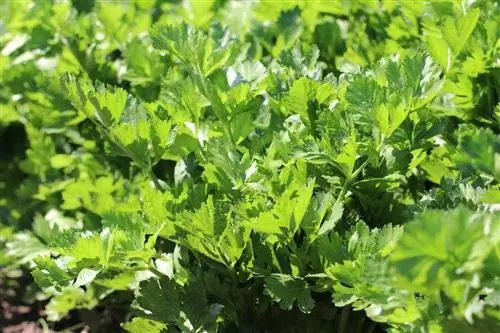
Floor
Because they are heavy feeders, they are better grown on heavy than light soils. Humus-rich, loamy soils that are improved with compost are good. In sandy soils, the stalks or tubers remain smaller, which is why sandy soils should be stimulated to form humus with increased amounts of compost.
Sowing / Planting
- Time: mid to end of March
- Sowing: prefer under glass
- Sowing celery directly
- only cover thinly with soil (light germinator)
- Planting: mid to late May
- Space requirement: at least 40×40 cm
- Do not cover celeriac tubers with soil when planting
Note:
If it is too cold when planting, the celery tends to bloom.
Care
Hip and mulch regularly between the celery plants, this prevents weeds from forming and reduces evaporation. However, they are shallow-rooted, so care must be taken when chopping.
Special feature of celery
For bleaching celery, the stalks of the celery must be bleached and the soil around the plant is piled up. Another variant is to tie the stems together and cover them with thick, dark paper or cardboard. Bleaching makes the taste milder. Growing self-bleaching varieties saves extra work.
Watering & Fertilizing
Celery needs a lot of water to form large tubers and fleshy stalks. It needs regular, thorough watering. If it is dry, additional water is given.
Refertilize celeriac in particular once or twice more. Use compost or other organic material for this. Horn meal or horn shavings are well suited. Mulching also contributes to ongoing fertilization.
Harvesting & Storage
Celeriac
Harvesting begins in October as soon as the outer leaves turn yellow. Remove the tubers from the ground, use them directly or store them. To do this, cut back the outer leaves and wrap the tuber in moist sand in a cool place. Celeriac tolerates light frost.
celery stalks
The harvest takes place from around July until the first frosts, after which the stalks are no longer edible. The plant forms new stems when the outer ones are removed. Celery is harvested whole by cutting off the plant directly above the ground. Celery can be eaten raw. It is also suitable for cooking and steaming. The sticks will stay fresh for a few days in a moistened kitchen towel. They should be stored in the refrigerator.
Celery
The herb is very versatile. Harvest as soon as the leaves are large enough. They can be used raw, dried or cooked. They are also suitable for longer storage.
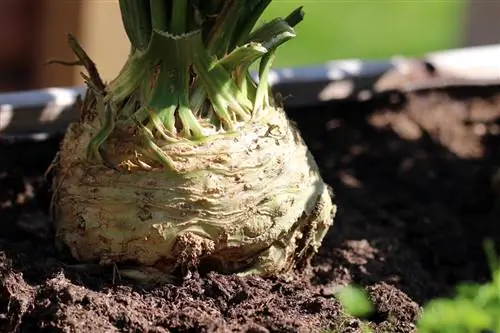
Note:
Celerium and celeriac are also suitable for freezing.
Varieties
Celeriac:
- 'Monarch' (large, easily stored tuber)
- ‘Ibis’ (white flesh, bulletproof)
- ‘Prinz’ (easy to care for, robust)
Celery stalk:
- 'Darklet' (sow early, in February, harvest from July)
- ‘Tall Utah’ (very productive, mild taste)
- 'Spartacus' (particularly long stems)
- 'Golden Spartan' (yellow-green, fast-growing)
- ‘Pascal’ (self-bleaching)
Diseases
Leaf spot disease
This disease is caused by fungi and can be recognized by yellowish spots on the leaves. It is treated with appropriate pesticides. It is better to prevent this by keeping the plants as dry as possible and in an airy location.
Celery scab
Cracked areas form on the celery tubers through which putrefactive fungi can penetrate into the storage area. The celery therefore has a less stable shelf life. Once the disease has broken out, it cannot be combated. Therefore, make sure to only plant young plants when the soil has warmed up sufficiently. Also pay attention to crop rotation and take a planting break of several years.
Pests
Aphids
Aphids like to settle especially in the narrow spaces between the celery stalks in order to suck plant juices. As long as there are only a few animals, beneficial insects take care of the pests. A mild soap solution that is used to rinse the plants helps with many lice.
Snails
Snails are a problem especially for young plants. These are protected by so-called snail collars for individual plants or the bed is bordered with a snail fence.
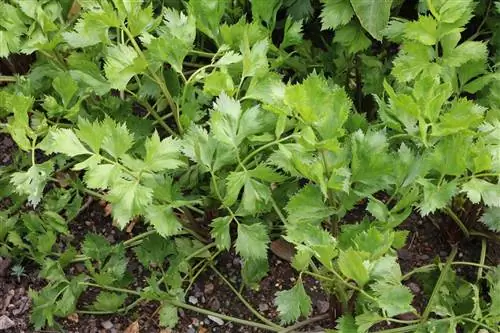
celery fly
Similar to the carrot or onion fly, this insect is attracted by the smell of the plants and lays its eggs on the stems. The larvae eat tunnels into the interior of the plant and sometimes make it inedible. In addition, the tubers can remain significantly smaller or become stunted. The most effective against vegetable flies of all kinds are dense plant protection nets that are spread over the crop. They must have good contact with the ground so that flies cannot get in anywhere.
Nematodes
The tiny nematodes that are not visible to the naked eye are a soil problem. They can attack many types of vegetables and damage their growth. Fighting roundworms is extremely difficult. On the one hand, all infected plants must be disposed of; on the other hand, in stubborn cases, the only solution is to leave the area permanently fallow, which means that no weeds are allowed to grow there. The nematodes are starved for months.
Note:
Growing certain plants such as marigolds has a soil-improving effect and can suppress nematodes.
Voles
Voles also cause a lot of damage to the vegetable garden. They like to eat tuber vegetables, including celeriac. Preventing them from doing so is very difficult. One option is to completely cover the beds with deeply buried wire mesh. Ultrasound machines promise relief, but they don't work particularly well. Hiding places for larger beneficial insects such as weasels are more helpful. Hikes for birds of prey can also help. There are special traps for the voles' passages.
Mixed Culture
Vegetables in mixed culture support each other; for example, they drive away certain pests with their smells. Celery is suitable for mixed cultivation with cabbage, fruit vegetables and leeks. Celery goes well with garlic in the herb bed. Parsley, potatoes or corn are less suitable.
Note:
Since celery is an umbelliferous plant, all varieties of the plant should not be grown after other umbelliferous plants. These include carrots and fennel.
Seed collection
Of course you can buy celery seeds everywhere. However, growing your own seeds has advantages. Only seed-resistant varieties are suitable for this, i.e. no hybrid breeds. Celery blooms when planted too cold. For seed production this means that some plants are planted at the beginning of May or the end of April. The umbels ripen on the plant but are cut before the seeds fall. The seeds will continue to ripen for a while in a dry place. If they are completely dry, they can be shaken out of the cones. The seeds will keep in a tightly closed container at least until the next sowing.

